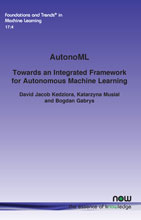AutonoML: Towards an Integrated Framework for Autonomous Machine Learning
By David Jacob Kedziora, Complex Adaptive Systems Lab, University of Technology Sydney, Australia, david.kedziora@uts.edu.au | Katarzyna Musial, Complex Adaptive Systems Lab, University of Technology Sydney, Australia, katarzyna.musial-gabrys@uts.edu.au | Bogdan Gabrys, Complex Adaptive Systems Lab, University of Technology Sydney, Australia, bogdan.gabrys@uts.edu.au
Abstract
Over the last decade, the long-running endeavour to automate high-level processes in machine learning (ML) has risen to mainstream prominence, stimulated by advances in optimisation techniques and their impact on selecting ML models/algorithms. Central to this drive is the appeal of engineering a computational system that both discovers and deploys high-performance solutions to arbitrary ML problems with minimal human interaction. Beyond this, an even loftier goal is the pursuit of autonomy, which describes the capability of the system to independently adjust an ML solution over a lifetime of changing contexts. However, these ambitions are unlikely to be achieved in a robust manner without the broader synthesis of various mechanisms and theoretical frameworks, which, at the present time, remain scattered across numerous research threads. Accordingly, this review seeks to motivate a more expansive perspective on what constitutes an automated/autonomous ML system, alongside consideration of how best to consolidate those elements. In doing so, we survey developments in the following research areas: hyperparameter optimisation, multicomponent models, neural architecture search, automated feature engineering, meta-learning, multi-level ensembling, dynamic adaptation, multi-objective evaluation, resource constraints, flexible user involvement, and the principles of generalisation. We also develop a conceptual framework throughout the review, augmented by each topic, to illustrate one possible way of fusing high-level mechanisms into an autonomous ML system. Ultimately, we conclude that the notion of architectural integration deserves more discussion, without which the field of automated ML risks stifling both its technical advantages and general uptake.
AutonoML: Towards an Integrated Framework for Autonomous Machine Learning
Over the last decade, the long-running endeavour to automate high-level processes in machine learning (ML) has risen to mainstream prominence. Beyond this, an even loftier goal is the pursuit of autonomy, which describes the capability of the system to independently adjust an ML solution over a lifetime of changing contexts.
This monograph provides an expansive perspective on what constitutes an automated/autonomous ML system. In doing so, the authors survey developments in hyperparameter optimisation, multicomponent models, neural architecture search, automated feature engineering, meta-learning, multi-level ensembling, dynamic adaptation, multi-objective evaluation, resource constraints, flexible user involvement, and the principles of generalisation. Furthermore, they develop a conceptual framework throughout to illustrate one possible way of fusing high-level mechanisms into an autonomous ML system.
This monograph lays the groundwork for students and researchers to understand the factors limiting architectural integration, without which the field of automated ML risks stifling both its technical advantages and general uptake.
